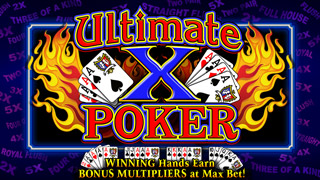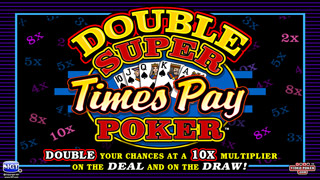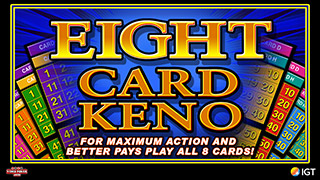Ultimate X
-
Sam14
- Forum Newbie
- Posts: 5
- Joined: Fri Feb 10, 2012 4:07 pm
Ultimate X
I know that playing a near-perfect strategy for any game in the Ultimate X format is humanly impossible, but can anyone tell me what the approximate return of these games would be if I used the appropriate BASIC strategy for the game? Using basic strategy, how does the return of an Ultimate X format version compare to the standard version? Does the variation improve the return if you consider only basic strategy?
I'm particularly interested in 7-5 Bonus and 10-6-4 Double Bonus.
Thanks,
Sam
I'm particularly interested in 7-5 Bonus and 10-6-4 Double Bonus.
Thanks,
Sam
-
New2vp
- Video Poker Master
- Posts: 1878
- Joined: Mon Sep 11, 2006 4:02 am
I know that playing a near-perfect strategy for any game in the Ultimate X format is humanly impossible, but can anyone tell me what the approximate return of these games would be if I used the appropriate BASIC strategy for the game? Using basic strategy, how does the return of an Ultimate X format version compare to the standard version? Does the variation improve the return if you consider only basic strategy?
I'm particularly interested in 7-5 Bonus and 10-6-4 Double Bonus.
Thanks,
SamEach game has to be calculated separately. And the answers are going to be different depending on whether you are playing single line, triple-play, five-play, or ten-play due to the fact that there are somewhat different multipliers in each version.Also, you need to define what you mean by basic play. If you mean using computer-perfect strategy for the base game, you will get one answer. Often "basic play" means using a strategy that ignores penalty cards. If you use a penalty-free strategy (presuming that you can settle on the best one) for the base game, that provides a 2nd answer. There are also computer-perfect and penalty-free versions of using a best single strategy at all times, regardless of the multipliers that are applicable for the hand. This last method generally gets you within less than 0.1% of the return for the strategy that you characterize as "humanly impossible."For 10-6-4 Double Bonus, 10-play, the non-Ultimate X base game has a computer-perfect return of 97.46%. A penalty-free strategy exists that allows a small deduction from that return, down to 97.45%.If you used that strategy to play Ultimate X, your return would actually be higher: 97.98% for the computer-perfect version and 97.93% for the penalty-free strategy. (Note: Keep in mind that your investment is 10 coins vs. 5 coins for the base game and that, since this is a negative game, your expected coins lost will be higher even though the return is better.)But you can adopt a different single strategy that takes into account the extra bonuses that you get, primarily by going after more straights and flushes. The computer-perfect version yields 98.58% and a penalty-free version pays 98.57%. This compares to the perfect version that is advertised at 98.60%. So you can get almost all the way to perfect by making a few strategy changes to the base game's method.The computer-perfect single Ultimate X strategy for 7-5 Bonus Poker yields 99.33%. Unfortunately, the answers are not as simple as the question.
-
Sam14
- Forum Newbie
- Posts: 5
- Joined: Fri Feb 10, 2012 4:07 pm
Thank you for your detailed response.
I have been able to calculate returns for the 10-6-4 DB game that correspond exactly to those you posted (97.98% using basic strategy and 98.58% using a strategy modified to account for the multipliers on the 10x pay table).
How do you respond to those who say that the strategy modified for the multipliers, which is heavily biased toward straights and flushes, would be perfectly appropriate ONLY if there were no current multipliers showing on the game?
It appears that if there are multipliers present, the correct strategy would be something between the two strategies. Can you suggest a practical way to deal with this issue?
I have been able to calculate returns for the 10-6-4 DB game that correspond exactly to those you posted (97.98% using basic strategy and 98.58% using a strategy modified to account for the multipliers on the 10x pay table).
How do you respond to those who say that the strategy modified for the multipliers, which is heavily biased toward straights and flushes, would be perfectly appropriate ONLY if there were no current multipliers showing on the game?
It appears that if there are multipliers present, the correct strategy would be something between the two strategies. Can you suggest a practical way to deal with this issue?
-
New2vp
- Video Poker Master
- Posts: 1878
- Joined: Mon Sep 11, 2006 4:02 am
How do you respond to those who say that the strategy modified for the multipliers, which is heavily biased toward straights and flushes, would be perfectly appropriate ONLY if there were no current multipliers showing on the game?The single strategy that I suggested here was not meant to be perfect for any particular set of multipliers. It is not biased enough toward straights and flushes when there is no multiplier present; and it is biased too much when the sum of the multipliers is beyond a certain point. If the multipliers present are about "average," the strategy is fairly close to being correct, but not exactly.It appears that if there are multipliers present, the correct
strategy would be something between the two strategies. Can you suggest a
practical way to deal with this issue?There are a couple different approaches, with the following caveat. To be very accurate in any of these would require quite a bit more work than would be reasonable to outline in any forum post and certainly might not have the financial return to be worth the effort. Because I put more value on playing a better strategy than I do on financial gain, I might choose a different level to stop than you would.One method is to calculate more than one strategy, two, three, or up to the number that you think you can handle for different ranges of the sum of the multipliers. The first strategy would be for no multipliers up to a small sum. The next would be for a sum that is a bit larger. And so on, up to one that is appropriate for the largest multipliers.A second method is to put together a strategy similar to what one might see for a progressive that consists of a base strategy with breakpoints for when one should make a different play when considering competing holds.Rather than re-invent the wheel here, I will direct you to an answer that I gave in the past (August 16, 2011).http://forum.videopoker.com/forum/forum ... 3066#43066
-
Sam14
- Forum Newbie
- Posts: 5
- Joined: Fri Feb 10, 2012 4:07 pm
Thanks again for the helpful responses, and for the reference.

























































